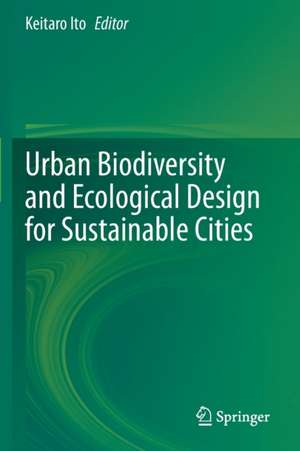Urban Biodiversity and Ecological Design for Sustainable Cities
Editat de Keitaro Itoen Limba Engleză Paperback – 25 mar 2022
All chapters explore and consider the relationship between humans and nature in cities, a subject which is taking on increasing importance as new cities are conceptualized and planned. These discussion and examples would be useful for urban ecology researchers, biologists, city planners, government staff working in city planning, architects, landscape architects, and university instructors. This book canalso be used as a textbook for undergraduate and postgraduate city planning, architecture or landscape architecture courses.
| Toate formatele și edițiile | Preț | Express |
|---|---|---|
| Paperback (1) | 732.82 lei 6-8 săpt. | |
| Springer – 25 mar 2022 | 732.82 lei 6-8 săpt. | |
| Hardback (1) | 1119.32 lei 6-8 săpt. | |
| Springer – 24 mar 2021 | 1119.32 lei 6-8 săpt. |
Preț: 732.82 lei
Preț vechi: 893.68 lei
-18% Nou
Puncte Express: 1099
Preț estimativ în valută:
140.22€ • 152.80$ • 118.16£
140.22€ • 152.80$ • 118.16£
Carte tipărită la comandă
Livrare economică 23 aprilie-07 mai
Preluare comenzi: 021 569.72.76
Specificații
ISBN-13: 9784431568957
ISBN-10: 4431568956
Ilustrații: X, 375 p. 196 illus., 134 illus. in color.
Dimensiuni: 155 x 235 mm
Greutate: 0.59 kg
Ediția:1st ed. 2021
Editura: Springer
Colecția Springer
Locul publicării:Tokyo, Japan
ISBN-10: 4431568956
Ilustrații: X, 375 p. 196 illus., 134 illus. in color.
Dimensiuni: 155 x 235 mm
Greutate: 0.59 kg
Ediția:1st ed. 2021
Editura: Springer
Colecția Springer
Locul publicării:Tokyo, Japan
Cuprins
PART I Chapter 1 Approach For Ecological Landscape And Urban Biodiversity.- Chapter 2 Diversity And Design On A Former Freight Rail-Yard.- Chapter 3 Biodiversity In The Day To Day Practice Of The Landscape Architect.- Chapter 4 Edible Landscapes: Relocalising Food And Bringing Nature Into North London.- Chapter 5 Landscape Design For Nature Restoration And In Urban Areas In Japan -Planning Process Of Designing A River Bank Fishway And Surroundings-.- PART II Chapter 6 Nature In The Cities - Places For Play And Learning.- Chapter 7 Greening School Grounds: Schools’ Role In A Biodiversity Process.- Chapter 8 Nature Environment And Management For Children’S Play And Learning In Kindergarten In Urban Forest, Kyoto, Japan.- Chapter 9 Ecological Evaluation Of Landscape Components Of The Tokushima Central Park Through Red-Clawed Crab (Chiromantes Haematocheir).- Chapter 10 Developing Urban Green Spaces And Effective Use Of Rooftop Spaces For Cooling And Urban Biodiversity.-PART III Chapter 11 Addressing Climate Change And Biodiversity Loss From An Urban Perspective: Linking Climate Co-Benefits And Urban Ecosystem Services In Sao Paulo City, Brazil.- Chapter 12 Evaluation Of Habitat Functions Of Fragmented Urban Forests For Wildlife ~ The Case Of Kitakyushu City.- Chapter 13 The Effects And Functions Of Spatial And Structural Characteristics Of Shrine Forests As Urban Green Space.- Chapter 14 Green Infrastructure As A Planning Response To Urban Warming A Case Study Of Taipei Metropolis.- Chapter 15 Green Infrastructure Planning For Asian Cities: The Planning Strategies, Guidelines, And Recommendations.
Notă biografică
Keitaro Ito
Professor, Laboratory of Environmental Design, Department of Civil Engineering, Kyushu Institute of Technology, Kitakyushu, Fukuoka, Japan
Professor, Laboratory of Environmental Design, Department of Civil Engineering, Kyushu Institute of Technology, Kitakyushu, Fukuoka, Japan
Textul de pe ultima copertă
This book highlights various designs for urban green spaces and their functions. It provides an interesting meeting point between Asian, European and North America specialists (researchers, planners, landscape architects) studying urban biodiversity; urban biodiversity and green space; relations between people and biodiversity. The most important feature of this book is the unique point of view from each contributor towards “the relationship between nature and people in urban areas”, in the context of the ecosystem and biodiversity in urban areas and how to manage them.
All chapters explore and consider the relationship between humans and nature in cities, a subject which is taking on increasing importance as new cities are conceptualized and planned. These discussion and examples would be useful for urban ecology researchers, biologists, city planners, government staff working in city planning, architects, landscape architects, and university instructors. This book can alsobe used as a textbook for undergraduate and postgraduate city planning, architecture or landscape architecture courses.
All chapters explore and consider the relationship between humans and nature in cities, a subject which is taking on increasing importance as new cities are conceptualized and planned. These discussion and examples would be useful for urban ecology researchers, biologists, city planners, government staff working in city planning, architects, landscape architects, and university instructors. This book can alsobe used as a textbook for undergraduate and postgraduate city planning, architecture or landscape architecture courses.
Caracteristici
Presents various practical examples of nature restoration and design Provides detailed descriptions of nature restoration and its methods Discusses ecosystems in urban areas and how they can be managed
